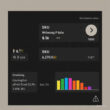In a highly competitive and rapidly changing technological environment, design is becoming a critical factor in the success of startups. To stand out from the competition and offer a truly innovative user experience, startup founders must stay on top of the latest trends and actively experiment with new approaches.
According to a recent Forbes article, Framer was facing a slowdown in revenue growth. Its founders changed their business model to expand their customer base and accelerate development. It’s allowed them to quadruple revenue in a year and a half.
Here are some of the key trends and technologies that are shaping the future of startup design.
Minimalism and clean interfaces
Users want intuitive applications that are easy to navigate and quick to find the needed features. To achieve it, the following minimalist design principles should be adhered to:
- Refusal of unnecessary details and decorations
- High level of simplicity and readability of the interface
- A clear visual hierarchy of elements
- Unobtrusive animation and color accents
- A large amount of negative space
For startups, focusing on minimalism is an opportunity to make their product intuitive and pleasant, which is critical in a highly competitive market. Consulting support from an experienced design agency like https://uitop.design/startup-design-services/ can be beneficial at this stage.
New ways of interaction
In addition to touch screens, new ways of interaction, such as gestures, voice commands, and augmented reality, are emerging and becoming famous. To keep up with the times, startup designers need to explore the possibilities of these new interfaces and look for ways to apply them to their products. It will allow them to create natural, intuitive, and engaging solutions.
Virtual and augmented reality
With the rise of VR/AR technologies, virtual worlds and the superimposition of digital objects on top of real space offer excellent prospects for startups in various fields, from entertainment to medicine. Many successful startups are already actively applying VR and AR capabilities to their products and services.
Potential areas for VR/AR applications are:
- Education and training
- Medicine
- Entertainment and games
- Architecture and design
- Retail and marketing
The application of augmented and virtual reality will enable the creation of truly innovative and exciting products and services.
Focusing on the advanced user
Today’s users of digital products are mostly tech-savvy and experienced in using applications. It makes it possible to move away from unnecessary hints and instructions, creating interfaces that give more freedom and flexibility to advanced users.
Here is how to design an interface for advanced users:
- Reduce the number of descriptions and tooltips
- Give more options for customization
- Offer colorful but unusual ways of interaction
- Don’t limit advanced users in what they can do
This approach will create products that will be interesting and valuable to a demanding audience.
Personalization
More and more products use user data to tailor content and recommendations to their preferences and habits. It opens up many opportunities to customize the design to make it more relevant to each user. For example, the app can dynamically change the color scheme based on a particular person’s preference.
Data-driven design
Collecting data on product usage and user behavior allows you to make informed design decisions, optimizing the interface for your audience’s needs. You can find the most effective solutions by experimenting and testing different variants. Then, constantly improve them based on new data.
Here is how to apply data-driven design:
- Collecting and analyzing usage data
- A/B testing
- Optimizing the design for key metrics
- Continuous iterations based on feedback
This approach will build a user experience that best matches the real needs and expectations of the audience.
Turning functions into visual metaphors
To make apps more intuitive, abstract functions and processes can be turned into visual metaphors — e.g., “folders” instead of categories, “recycle bin” for deleting, etc. Such familiar images make it easier to understand product features.
Examples of successful visual metaphors are:
- A mailbox for messages
- A shop for in-app purchases
- Library for a collection of media files
- Calendar for schedules and reminders
Clear metaphors will help make the startup more attractive and enjoyable for users.
Micro-animations and micro-interactions
Micro-animations will help to make the product more pleasant to use. It is worth adding effects such as:
- Loading or buffering animation
- Smooth appearance and disappearance of elements
- Tooltips and notifications
- Click and hover micro-animations
Proper micro-interactions will make a startup’s product more lively and engaging.
Trends in interfaces and app design
Apart from these key trends in startup design, there are many narrower trends shaping approaches to mobile and web app design:
- Design with an isometric perspective
- Asymmetrical and non-standard layouts
- Dynamic and vibrant fonts
- New ways of navigation (gestures, voice, etc.)
- Mini-games and gamification in the interface
- Interactive 3D elements
To create truly innovative products, startups must experiment and try new interface and interaction design ideas.
Conclusion
To create a successful digital product in the current realities, you must keep up with the times and consider general trends and emerging technologies in startup design, like augmented reality or voice interfaces.
As Medium emphasizes, the future of startups is promising, as emerging technologies and changing consumer needs create many opportunities for innovation and breakthroughs.
Companies that creatively integrate modern concepts and technologies will create genuinely innovative products that give them an edge over their competitors.




